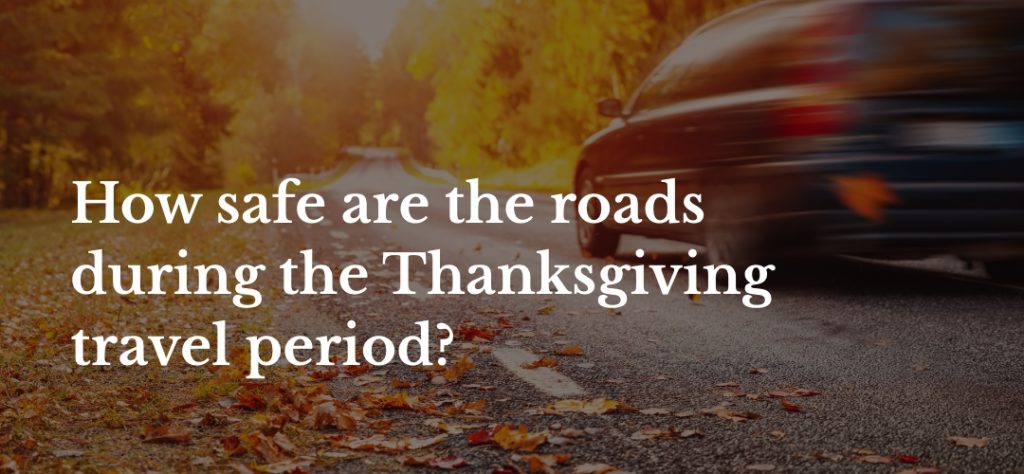
Thanksgiving is one of the biggest travel holidays in the United States, with a significant annual increase in vehicle traffic as families reunite to celebrate. According to AAA, in what is projected to be a record-breaking year, nearly 80 million people are expected to travel 50 miles or more during the Thanksgiving period in 2025.
Historically, the Wednesday before Thanksgiving and the Sunday after have been recognized as peak travel days. However, does this increase in road and highway traffic correspond with an increase in traffic collisions?
At Feagans Law Group, we worked with 1Point21 Interactive to find the answer. Together, we analyzed data from nearly 4 million crashes that occurred in 2022 through 2024. This representative data set comes from a four-state sample serving as regional proxies for the major census regions, the West (California data), the Midwest (Iowa), the South (Texas), and the Northeast (Massachusetts).
Thanksgiving Travel Safety Insights for 2025
Quick takeaways from a 3-year, 4-state collision study (2022–2024).
- Most dangerous day: Wednesday before Thanksgiving crashes spike ~15% nationally and as much as ~50% in the Northeast.
- Peak risk window: Begins around 11:00 AM and stays elevated through 8:00 PM mid-day travel patterns differ from normal weekdays.
- Safest travel days: Thanksgiving Day and Tuesday crash counts drop significantly. Black Friday also showed a 26% decrease in crashes.
Quick safety tips
- Leave early: 6–9 AM is the lowest-risk window on Wednesday.
- If you must go Wednesday, avoid the 11 AM–8 PM spike when possible.
- Buckle up, avoid distractions, and take regular breaks on long trips.
Regional differences matter. Plan routes and timing with local traffic conditions in mind.
Learn how we can helpRelative Crash Risk During the Week of Thanksgiving
As mentioned above in our key findings, the Wednesday before Thanksgiving is the most dangerous travel day of the holiday period. This finding falls in line with reports that this day is also one of the busiest travel days of the year. In general, the pre-Thanksgiving days all experience some level of crash increase, although much smaller increases than on Wednesday.
As you might expect, crashes are down precipitously on Thanksgiving Day — as most people have already made their trip and most businesses are closed due to the federal holiday.
Interestingly, and perhaps contrary to many analyses of the entire travel period, we found that the post-Thanksgiving period is safer relative to the rest of the year. Black Friday experienced a 26% decrease in crashes compared to a typical Friday, with decreases on Saturday and Sunday as well.
Highest Crash Risk by Time of Day: The Wednesday Before Thanksgiving
Despite the increase in collision risk on Wednesday, millions of people have already made plans and will have no choice but to drive on that day. We examined temporal collision patterns to help people understand how they may differ from a typical weekday.
Unlike typical weekdays, which exhibit distinct peaks during morning and evening rush hours with reduced activity mid-day, the Wednesday before Thanksgiving demonstrates a fundamentally different temporal pattern. Collisions increase gradually throughout the morning, spike sharply around 11:00 a.m., and remain consistently elevated through 8:00 p.m.
This sustained elevation contrasts with the characteristic bimodal distribution of normal weekday crashes, reflecting continuous heavy travel volumes associated with holiday departure patterns rather than discrete commuting periods. The chart below illustrates how the risk window shifts.
Regional Differences in Thanksgiving Travel Risk
This analysis is based on a sample of collision data from four states that serve as stand-ins for the four major U.S. Census regions. While the relative crash risk was highest on the Wednesday before Thanksgiving in all four regions, the increase in risk varied wildly.
In fact, we found that crashes increase by nearly 50% in the Northeast, by far the largest increase among regions. The Midwest experienced the second-highest increase at 15% (in line with the National average), followed by the South with 12% and the West with 8%.
This drastic increase in the Northeast may be due to characteristics of our sample state, Massachusetts, but is certainly not due to a small sample size. Our set included over 60,000 crashes in Massachusetts on Wednesdays alone. The disparity with the other regions may indicate differences in the state’s transportation network, or be more representative of the higher population density in the Northeast as a whole — both of which may be strained by holiday travel.
How To Use This Information: Thanksgiving Travel Safety Tips
Based on our findings, Thanksgiving Day is the safest day for long-distance travel, with crash counts averaging 32% lower than those of a typical Thursday. While families may compromise a full day of celebration, the data shows that drivers face the lowest risk. Another safe option is to leave on Tuesday, when crash risk is lowest in the days leading up to the holiday.
However, not everyone may have the flexibility to adjust their schedule, which helps explain why the Wednesday before Thanksgiving remains one of the busiest travel days of the year. Many must wait until a full or half-day of work before they can depart.
In such cases, drivers should leave as early as possible on Wednesday to avoid exposure to the highest crash risk windows. The safest hours for driving are 6 to 9 a.m., when crash risk is low. The second-best option is between 3 and 6 p.m.
Finally, as always, we encourage drivers to stay patient and alert. The roads will be crowded during the holiday period, but careful driving will help prevent crashes when risk is highest. Travelers should buckle up, avoid distractions, and take breaks when needed. These few simple precautions can make all the difference in keeping everyone safe.
Methodology and Fair Use
This study utilizes a composite collision dataset comprising three years of crash records from four states representing major U.S. Census regions: California (West), Texas (South), Iowa (Midwest), and Massachusetts (Northeast). The combined dataset spans the years 2022 through 2024 and contains over 3.7 million records.
We identified the accepted Thanksgiving holiday travel periods for the same three years and isolated collisions that occurred on these days. This allowed us to compare the collision risk on each specific weekday leading up to and following Thanksgiving to that of the corresponding historical weekday.
If you would like to share or report on our findings, please link back to this study so that readers can access the full study and context that we provide.




